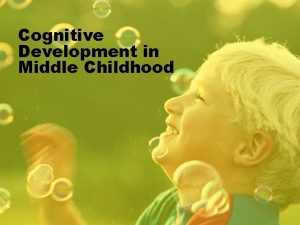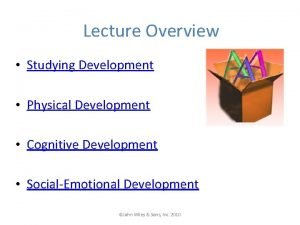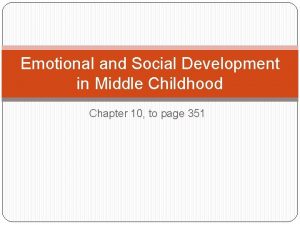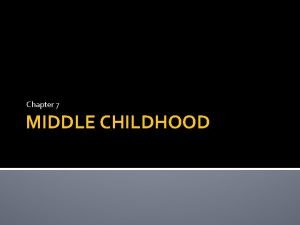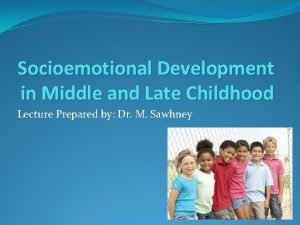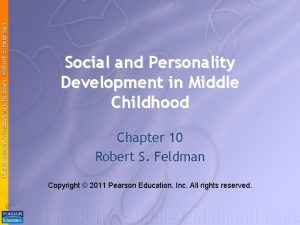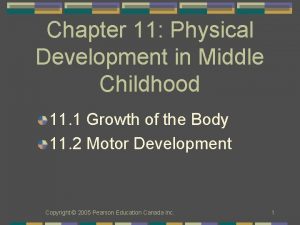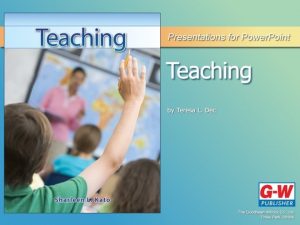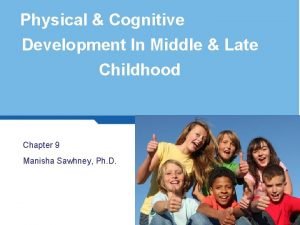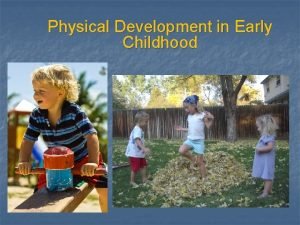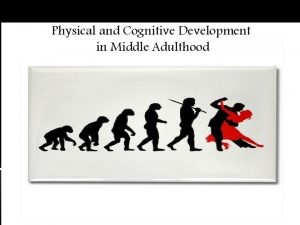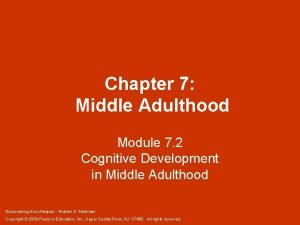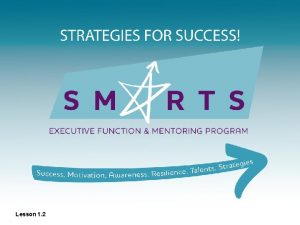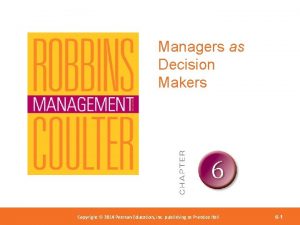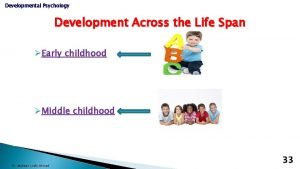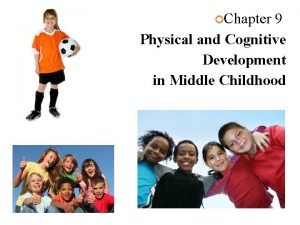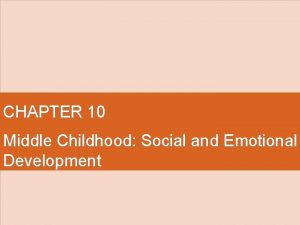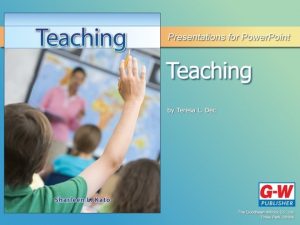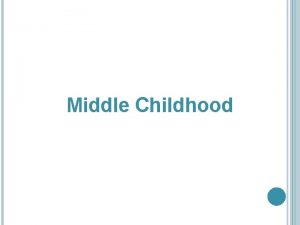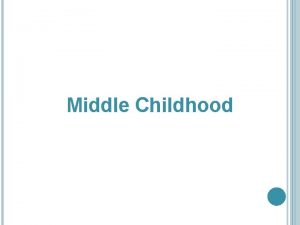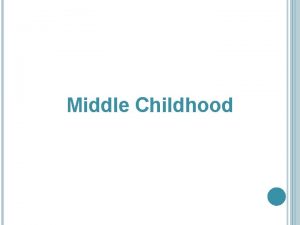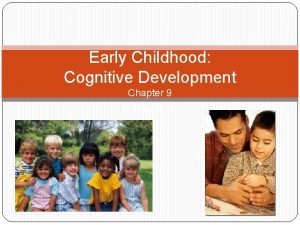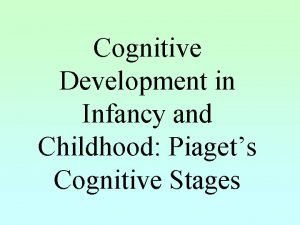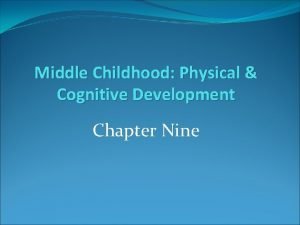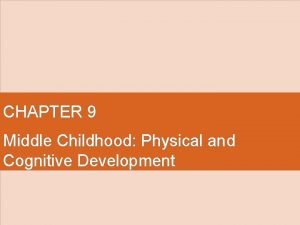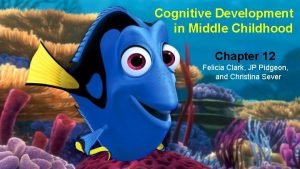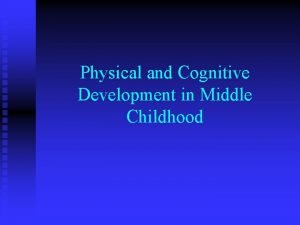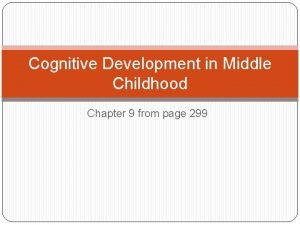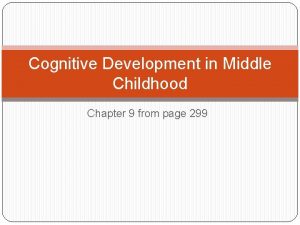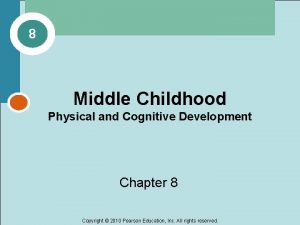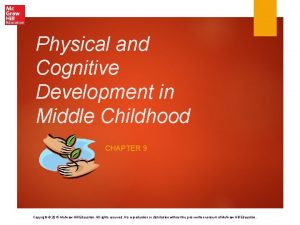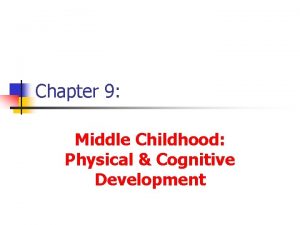Cognitive Development in Middle Childhood Thinking in Middle























- Slides: 23

Cognitive Development in Middle Childhood

Thinking in Middle childhood • Thought becomes more logical – Can now pass Piagetian conservation tasks • Understanding of spatial concepts improves – Can now give clear, well organanized directions; can draw and read maps

Attention in Middle Childhood Attention becomes more: • Selective • Adaptable • Planful

Steps in Planning • Postponing action to weigh alternatives • Organizing task materials n. Remembering steps of plan n. Monitoring how well plan works n. Revising if necessary

Development of Memory Strategies • Rehearsal – early grade school • Organization – soon after rehearsal – Knowledge base helps organization • Elaboration – end of middle childhood – Meaningful chunks of information • Schooling promotes using these memory strategies

Theory of Mind in Middle Childhood • See mind as active, constructive • Understand more about sources of knowledge – Mental inferences – False beliefs • Consider interactions of variables • Schooling promotes developing theory of mind

Explaining Differences in IQ • Genetics – Accounts for about half of differences • Environment – SES – Culture • Communication styles • Cultural bias in test content

Stereotype Threat • The fear of being judged on the basis of a negative stereotype that can trigger anxiety that interferes with performance – Ex: Girls don’t do well on Math exams…

Language Development in Middle Childhood • Vocabulary – Increases fourfold during school years – 20 new words a day • Grammar – Passive voice – Infinitive phrases • Pragmatics – Adjust to people and situations – Phrase requests to get what they want

Learning Two Languages • Bilingual Development – Learn both languages at the same time – Learn first language, then second – Sensitive period - childhood • Bilingual Education – Language immersion – Bilingual education

Psychosocial Development in Middle Childhood

Self-Concept in Middle Childhood • More refined me-self – Social comparisons – Emphasize competencies • Both positive and negative • Cognitive development affects structure of self-concept – Perspective taking • Social & cultural development affect content of self-concept – Real self vs. ideal self

Influences on Self-Esteem • Culture • Child-rearing practices • Messages from adults • Attributions – Mastery-oriented – Learned helplessness

Achievement-Related Attributions Mastery-Oriented • Attribute success to ability • Incremental view of ability – Can improve by trying • Focus on learning goals Learned Helplessness • Attribute failure to ability • Fixed view of ability – Cannot be changed • Focus on performance goals

Emotional Development in Middle Childhood • Self-Conscious Emotions – Pride – Guilt • Emotional Understanding – Explain using internal states – Understand mixed emotions • Emotional Self-Regulation – Motivated by self-esteem and peer approval – Emotional self-efficacy

Peer Groups • Formed from proximity, similarity • Adopt similar dress and behavior • Peer Culture – Relational aggression – Exclusion

Friendship in Middle Childhood • Personal qualities, trust become important • More selective in choosing friends • Friendships can last several years • Influence each other’s behavior

Family Relationships • Parents – Coregulation • Siblings – Rivalry – Companionship and assistance

Types of Families • • Traditional Employed parents One-child Gay & lesbian parents Single parents Divorced parents Blended Extended

International Divorce Rates

Consequences of Parental Divorce Immediate • Instability, conflict, drop in income • Parental stress, disorganization • Consequences affected by: – Age – Temperament – Sex Long-Term • Improved adjustment after 2 years • Boys, children with difficult temperaments more likely to have problems • Father’s involvement affects adjustment

Helping Families Through Divorce • Divorce mediation • Joint custody • Child support

Blended Families Mother-Stepfather Father-Stepmother • Most frequent • Boys usually adjust quickly • Girls adapt less favorably • Older children and adolescents of both sexes display more problems • Often leads to reduced father-child contact • Children in fathers’ custody often react negatively • Girls & stepmothers slow to get along at first, more positive interaction later
 Late childhood cognitive development
Late childhood cognitive development Language development in middle childhood
Language development in middle childhood Middle childhood and adolescence
Middle childhood and adolescence Ap psych schema
Ap psych schema A vygotskian classroom promotes ________.
A vygotskian classroom promotes ________. Cognitive development in childhood
Cognitive development in childhood Module 47 infancy and childhood cognitive development
Module 47 infancy and childhood cognitive development Middle childhood social and emotional development
Middle childhood social and emotional development Physical development in middle childhood
Physical development in middle childhood Late childhood socioemotional development
Late childhood socioemotional development Personality development in middle childhood
Personality development in middle childhood Physical development in middle childhood chapter 11
Physical development in middle childhood chapter 11 Middle childhood growth and development
Middle childhood growth and development Late development vs autism
Late development vs autism Physical development in middle childhood
Physical development in middle childhood Intellectual development middle adulthood
Intellectual development middle adulthood Middle adulthood cognitive development
Middle adulthood cognitive development Cognitive and non cognitive religious language
Cognitive and non cognitive religious language Cognitive flexibility meaning
Cognitive flexibility meaning Cognitive thinking
Cognitive thinking Thinking humanly: the cognitive modeling approach
Thinking humanly: the cognitive modeling approach Developmental psychology meaning
Developmental psychology meaning Middle and late childhood
Middle and late childhood Selman called stage 3 of friendship (ages 10 to 15),
Selman called stage 3 of friendship (ages 10 to 15),

